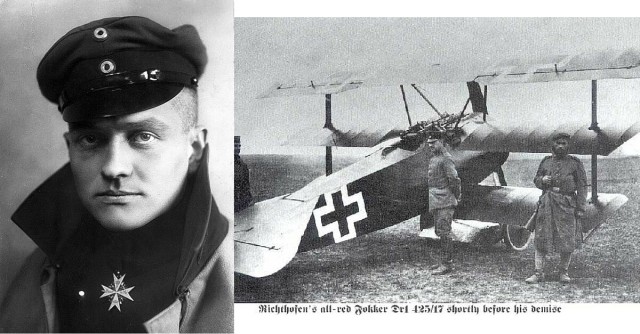
During World War I a scarlet triplane terrorized the skies over France. This image is one that many people conjure when they think of Manfred von Richthofen, or the Red Baron. Today, a similar triplane may be seen flying over the skies of The Old Rhinebeck Aerodrome in New York State.[1] This powerful museum brings the aircraft of WWI to life with its weekend airshows and staged dogfights; it also houses fascinating history of aircraft and war memory in regards to the Red Baron. It is important to note that the stereotypical image of the Red Baron, which has been instilled into popular culture through toys, models, and a cartoon strip featuring a loveable beagle, is far from accurate. Many aspects of Richthofen’s life to this day are depicted incorrectly, from the aircraft he flew, to his personal mannerisms and how this legendary battle flyer has been memorialized.[2]
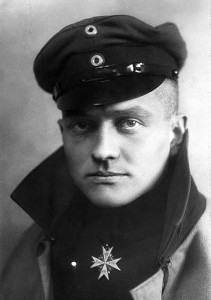 Manfred von Richthofen, the Red Baron.
Manfred von Richthofen, the Red Baron.Richthofen started his military career in the cavalry, however when given the opportunity to fly he took full advantage. The young officer learned to fly under Germany’s premier ace, Oswald Boelke.[3] Boelke taught his “cubs” how to fly in addition to the proper techniques required for attacking an enemy aircraft.[4] These strategies became known as the “Dicta of Boelke.”[5] Richthofen used this throughout his flying career and passed it on to the young pilots who he would later train. Under his mentor, Richthofen learned not only what it took to fly, but also what it took to be an ace. Moreover, it was at this time that he yearned to become the best of the best.[6]
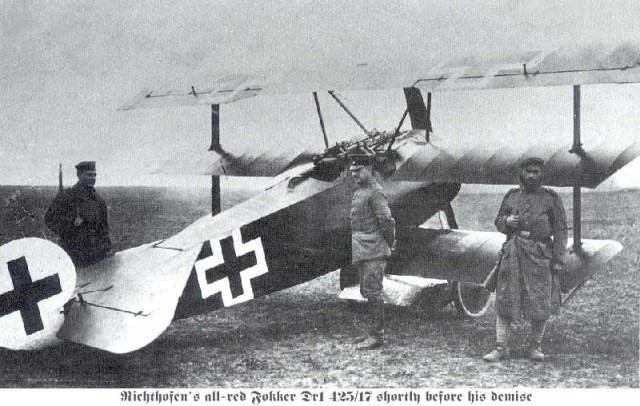 Richthofen’s all-red Fokker Dr.I.
Richthofen’s all-red Fokker Dr.I.One of the largest misconceptions about Richthofen was that he spent most of his time and scored most of kills in the famous Fokker Dr. I Triplane. In reality, the Red Baron spent most of his time in various Albatross D. model airplanes, where he scored fifty-five of his eighty kills. In comparison, he scored only nineteen kills in his famous Fokker.[10] While many historians are aware of this triplane fallacy, it has had a great impact on modern war memory. In 1967, Old Rhinebeck Aerodrome founder, Cole Palen, built a scale reproduction of the Fokker Dr. I Triplane to fly in his New York State airshows. Palen, with no intention of painting the aircraft red painted it yellow, as this was the color that was available to him, and relatively inexpensive. While Palen’s accomplishment of building this reproduction in the Empire State was ground breaking by making the practice of home building aircraft popular, it also brought to life a piece of war commemoration that was believed to be lost, as there are no original triplanes left in existence. Unfortunately for Palen, the public and patrons were more focused on the paint scheme than the actual aircraft.[11] Chris Bulko, a current pilot at Rhinebeck explains that, “people did not want to see a yellow triplane, they wanted red.”[12] As time passed, Palen received letters and postcards that asked why his triplane was not red, and if it would be painted red, one such postcard that sticks out only had one word written on it in all capital letters, “RED.”[13]
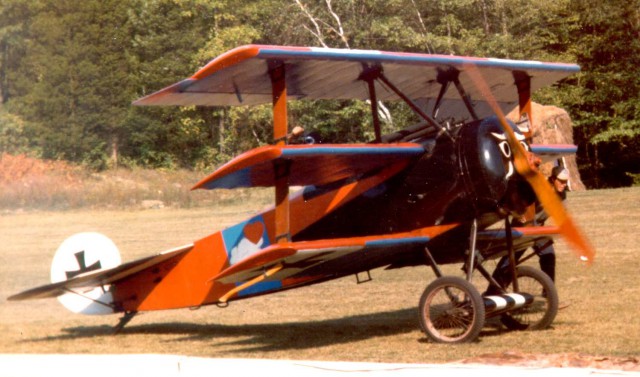 Cole Palen’s N3221 rotary-powered Dr.I reproduction – Wikipedia
Cole Palen’s N3221 rotary-powered Dr.I reproduction – WikipediaDue to the public outcry, Cole Palen acquiesced and painted his triplane the same color of Richthofen’s aircraft. However, Palen did not want his plane to solely be a piece of Red Baron memorabilia and came up with an ingenious idea to solve this dilemma. Along with the red paint Palen would put trademark insignias from other World War I German aces who flew the Fokker triplane on his aircraft. Along with Richthofen three other aces are represented. Most notably was Richthofen’s close friend and one time wingman Werner Voss. Voss is represented on the Rhinebeck triplane in two very distinctive ways. The first being the moustached face painted on the black cowling that covers the engine, also, a red heart painted on the left side on the plane. To avoid patrons of the museum confusing the plane for being only the Red Baron’s, the insignias of other aces are also distinguished. [14]
The Old Rhinebeck Aerodrome also features another astonishing piece of World War I aviation war memory. The Albatross D. Va, an aircraft that Richthofen scored only six kills in, but is of the same type of plane that he gained most of his victories piloting and originally painted red. While the Albatross at the museum is not painted red, it is noted during airshows that this was the Red Baron’s favorited aircraft design.[15]
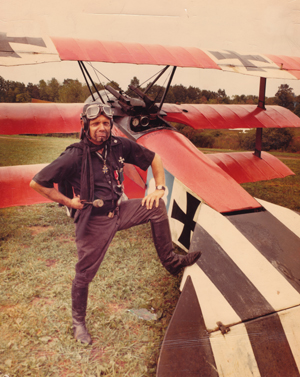 Cole Palen as the Evil Black Baron of Rhinebeck
Cole Palen as the Evil Black Baron of RhinebeckWhile the physical war memory that Old Rhinebeck offers is notable, there is another more personal level to it. During the Aerodrome’s traditional World War I Sunday airshows, Cole Palen, assumed the character of the villainous “Black Baron” while flying his triplane in mock dogfights against his friend Dick King and his Sopwith Camel.[16] While Palen’s character was not directly based on Richthofen, there are fictional similarities between the two.[17] They are both looked upon, or played the part of a villain. This characteristic helped to launch Palen’s airshows into popularity, however, this same characteristic led to a fictional depiction of Manfred von Richthofen. Richthofen was not a villainous person nor a blood thirsty scoundrel, as film and other media sources portrayed him. The real Red Baron fancied himself more as a sportsman than a soldier and was so greatly respect by the enemy that the British gave him a funeral with full military honors upon his death.[18]
Consequently, the Red Baron, or Manfred von Richthofen, has become a highly fictionalized character in history. While at times this is frustrating for many historians, it does help draw great interest from diverse people. Additionally, it has been shown that some people do not necessarily care about the history of Richthofen, but are more interested in the fictional interpretations. Even so, museums such as the Old Rhinebeck Aerodrome have the critical pieces of war memory and utilizes their large-scale artifacts to teach history through both fact and fiction.[19]
Works Cited:
- Bulko, Chris. Interview by author. Bethlehem, PA, April 3, 2015.
- Burrows, William E. Richthofen: A True History of the Red Baron. New York: Harcourt, Brace World, INC, 1969.
- Old Rhinebeck Aerodrome. “Albatross D.Va.” http://oldrhinebeck.org/ORA/albatros-d-va/.
- Old Rhinebeck Aerodrome. “Fokker Dr.1 Triplane.” http://oldrhinebeck.org/ORA/fokker-dr-1-triplane-2/.
- Old Rhinebeck Aerodrome. “Home.” http://www.oldrhinebeck.org/.
- Richthofen, Manfred von. The Red Battle Flyer. New York, New York: Harper Torch, 2014. iBooks.
- The Aerodrome. “Manfred von Richthofen.” http://www.theaerodrome.com/aces/germany/richthofen2.php.
Notes
[1] Old Rhinebeck Aerodrome, “Home,” http://www.oldrhinebeck.org/. The Old Rhinebeck Aerodrome is located about three and a half hours east of Chemung county New York. This museum houses a large collection of early aircraft, engines, cars, and motorcycles. The museum is open daily June through October, with Airshows on Saturdays and Sundays. The Saturday shows chronicle the history of early flight through the First World War, while the Sunday airshows feature mock dogfights.[2] Old Rhinebeck Aerodrome, “Home,” http://www.oldrhinebeck.org/.: William E. Burrows, Richthofen: A True History of the Red Baron, (New York: Harcourt, Brace & World, INC, 1969), 137, 238-239.: Manfred von Richthofen, The Red Battle Flyer, (New York, NY: Harper Torch, 2014), iBooks, 119.
[3] Burrows, Richthofen, (New York: Harcourt, Brace & World, INC, 1969), 123, 104. During the World War One, a German ace was a pilot who had shot down ten or more aircraft.
[4] Burrows, Richthofen, (New York: Harcourt, Brace & World, INC, 1969), 39, 81.: Richthofen, Battle Flyer, (New York, NY: Harper Torch, 2014), iBooks, 20-40. “Cubs” was a term used by Oswald Boelke when describing his young trainee pilots.
[5] Burrows, Richthofen, (New York: Harcourt, Brace & World, INC, 1969), 88-90.
[6] Ibid., 123, 104.
[7] Burrows, Richthofen, (New York: Harcourt, Brace & World, INC, 1969), 6-19. A kill in terms of aerial war does not necessarily mean the death of another pilot but rather an aircraft that has been shot down.
[8] Burrows, Richthofen, (New York: Harcourt, Brace & World, INC, 1969), 104, 119, 114-115.: Richthofen, Battle Flyer, (New York, NY: Harper Torch, 2014), iBooks, 84-85.
[9] Burrows, Richthofen, (New York: Harcourt, Brace & World, INC, 1969), 200-205, 195.
[10] Burrows, Richthofen, (New York: Harcourt, Brace & World, INC, 1969), 104, 140, 170.: The Aerodrome, “Manfred von Richthofen,” http://www.theaerodrome.com/aces/germany/richthofen2.php.
[11] Old Rhinebeck Aerodrome, “Fokker Dr.1 Triplane,” http://oldrhinebeck.org/ORA/fokker-dr-1-triplane-2/.: Chris Bulko, interview by author, Bethlehem, PA, April 3, 2015.
[12] Chris Bulko, interview by author, Bethlehem, PA, April 3, 2015.
[13] Ibid.
[14] Chris Bulko, interview by author, Bethlehem, PA, April 3, 2015.: Burrows, Richthofen, (New York: Harcourt, Brace & World, INC, 1969), 173.
[15] Old Rhinebeck Aerodrome, “Albatross D.Va,” http://oldrhinebeck.org/ORA/albatros-d-va/.: Chris Bulko, interview by author, Bethlehem, PA, April 3, 2015.: Burrows, Richthofen, (New York: Harcourt, Brace & World, INC, 1969), 170.: The Aerodrome, “Manfred von Richthofen,” http://www.theaerodrome.com/aces/germany/richthofen2.php.
[16] Old Rhinebeck Aerodrome, “Fokker Dr.1 Triplane,” http://oldrhinebeck.org/ORA/fokker-dr-1-triplane-2/.: Chris Bulko, interview by author, Bethlehem, PA, April 3, 2015.
[17] Today, the Character of the “Black Baron” lives on during the aerodromes airshows.
[18] Burrows, Richthofen, (New York: Harcourt, Brace & World, INC, 1969), 239, 137, 205, 243.: Chris Bulko, interview by author, Bethlehem, PA, April 3, 2015.
[19] Burrows, Richthofen, (New York: Harcourt, Brace & World, INC, 1969), 239, 241.; Chris Bulko, interview by author, Bethlehem, PA, April 3, 2015.

Δεν υπάρχουν σχόλια:
Δημοσίευση σχολίου